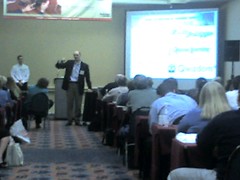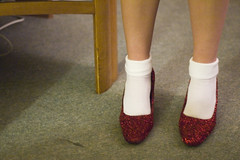 |
 |
I’ve spent a good number of hours lately wandering around in Second Life (SL). For those of you who may not know, SL is a 3D virtual space where people can come, represent themselves with Avatars (kinda like a pupet), interact, build, do business, and have fun — in just about any way that you can imagine, and probably ways that I couldn’t imagine. Some spaces, or islands have been purchased and dedicated to educational applications, and educators have started populating these islands — like crazy.
I visited again this morning, and am sure that there are buildings there that weren’t there yesterday — big ones. I must admit a real sense of space there, and I’ve already made some friends, most of whom I have no idea who they are in RL (that’s real life). I did meet one guy (I guess) who admitted to being a principal in Vermont. He wouldn’t share his name, however, for fear of my thinking that all principals in Vermont have nothing better to do than wonder around, zombie like, in Second Life.
This is certainly not true, and no-one’s a zombie here. We all knocking around, kicking the tires, pushing the envelope on possibilities of using this as a learning space. I’ve learned to walk — fairly smoothly. I can even navigate spiral stairs, a feat that would have been impossible only a few days ago. I get a special pleasure from flying. The sound of the air rushing by your ears (out of the computer’s speakers) is invigorating, and I can now find my way from the ISTE center to my home at about 200 feet above the ground. I just turn left, take a right at the volcano, and then only a few more blocks.
The real pleasure (and instructional potential in my opinion) is the building. There are a lot of buildings here, and everyone seems interested in keeping to a contemporary style of straight lines and lots of glass (makes me feel like a voyeur sometimes). But what if we could have a place to really open things up, with caves where students could add cave drawings, neolithic villages, bronze-age cities, etc. — a continent, maybe where different sections are devoted to stuff from specific millennia — most of it built by learners.
Science is wide open as well. I found, at one point, a giant paramecium, floating above a lagoon. I tried to find it again this morning, but without success. So students making 3D single-celled organisms to demonstrate their knowledge of those plasm things would likely be a thrill. But let’s take this up to Second Life 2.0 (sorry). What if the teacher could define certain behaviors of an environment, setting laws of nature, so to speak. And then ask students to invent organisms that interact and flourish in that environment, working within an ecosystem?
None of this is new, as many of you know. Kids have been building worlds for more than a decade in MUDs and MOOs, and computer scientists have been creating ecosystems where organisms of programming code were designed to hunt, eat, and thrive. What I find interesting is the potential to create such rich constructivist learning environments and make them this accessible to young (and old) learners.
More later! It’s time to get to work — in RL!

 Yesterday morning, I was working in my office, with my headphones on, and suddenly heard this loud echo’y crackle. I pulled the phones off, and continued to listen, and heard only Brenda moving around upstairs. Nothing there to indicate such a noise, but I continued working. A minute later, she came down and asked, “Want to go see?”
Yesterday morning, I was working in my office, with my headphones on, and suddenly heard this loud echo’y crackle. I pulled the phones off, and continued to listen, and heard only Brenda moving around upstairs. Nothing there to indicate such a noise, but I continued working. A minute later, she came down and asked, “Want to go see?”
 James O’Hagan, over at
James O’Hagan, over at  I’m sitting in JFK airport, just landed here, from Orlando. Next I’ll hop on another flight for Raleigh. I know! I’m sure that somewhere, at some level, it makes sense. I’ve wanted to try Jet Blue for a while, and it’s all true. The seats where more comfortable, with more room, and each seat had a TV display, which played TV. I mean it, Fox, NBC, CBS, History, at least five sports channels, and three pay movies ($5 with a card swipe there at the seat). That was nice. But it was TV. I watched an old episode of The West Wing on my computer instead. Here in the airport, Jet Blue does provide free WiFi.
I’m sitting in JFK airport, just landed here, from Orlando. Next I’ll hop on another flight for Raleigh. I know! I’m sure that somewhere, at some level, it makes sense. I’ve wanted to try Jet Blue for a while, and it’s all true. The seats where more comfortable, with more room, and each seat had a TV display, which played TV. I mean it, Fox, NBC, CBS, History, at least five sports channels, and three pay movies ($5 with a card swipe there at the seat). That was nice. But it was TV. I watched an old episode of The West Wing on my computer instead. Here in the airport, Jet Blue does provide free WiFi. I’ve written before about trying to identify the qualities of video games that make their play so compelling, and figuring out how to restructure classroom assignments so that the include these qualities. It’s occured to me, lately, that some of these qualities may already be there, that they may have been used before, it’s just that we weren’t thinking about their power with millennials. I mentioned this yesterday and shared that David Williamson Shaffer, in his book,
I’ve written before about trying to identify the qualities of video games that make their play so compelling, and figuring out how to restructure classroom assignments so that the include these qualities. It’s occured to me, lately, that some of these qualities may already be there, that they may have been used before, it’s just that we weren’t thinking about their power with millennials. I mentioned this yesterday and shared that David Williamson Shaffer, in his book,  Live Blogged
Live Blogged


 Several days ago, the U.S. Department of Education published to Congress, the results of a recent study on the effects of computer software on reading and math test scores. The report said…
Several days ago, the U.S. Department of Education published to Congress, the results of a recent study on the effects of computer software on reading and math test scores. The report said…